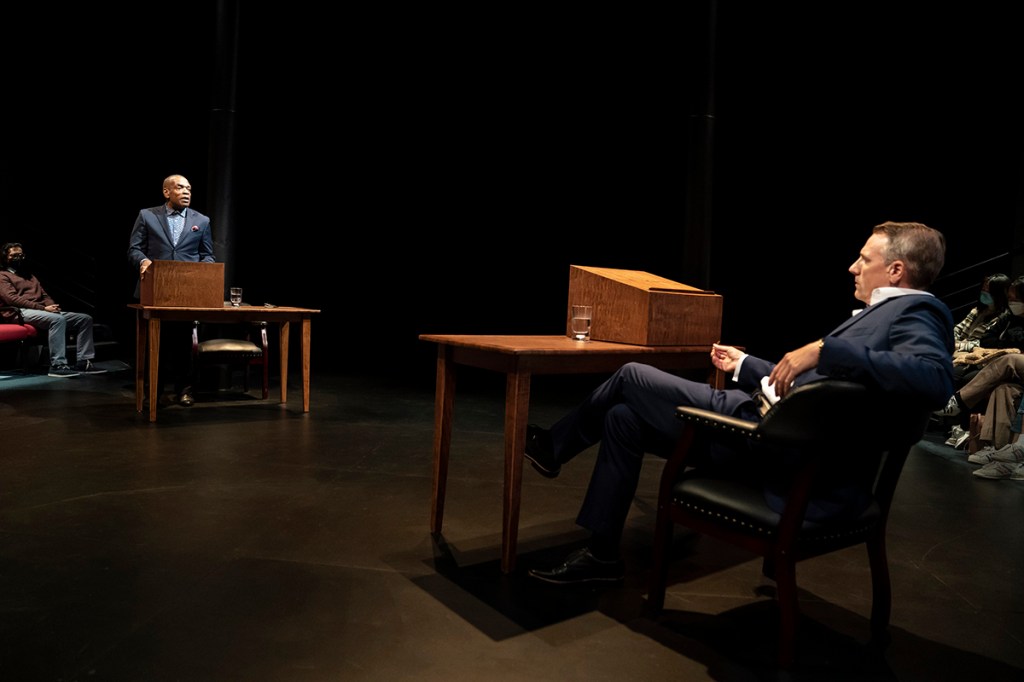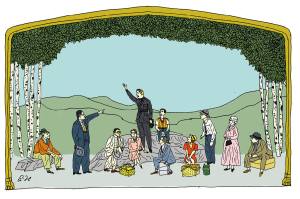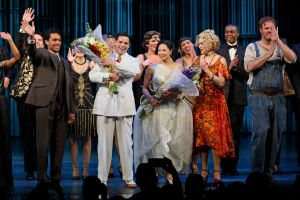It’s fair to ask what James Baldwin would have made of Baldwin and Buckley at Cambridge, the Public Theater’s recent presentation of his famous 1965 debate against William F. Buckley Jr. It’s not that the show doesn’t strain mightily to champion Baldwin in the contest — it does — but the novelist viewed what he called “problem” or “protest” art with particular scorn. This was a writer who torched fellow travelers Harriet Beecher Stowe and Richard Wright in the same breath for perpetuating, in his view, the same “monstrous legend” of racial inferiority. To call Baldwin an activist or a champion of civil rights doesn’t quite cover it: the man operated on a theological plane, aiming at spiritual transformation. His standards for art were notoriously exacting.
The experimental company Elevator Repair Service makes a practice of staging word-for-word reenactments. This new show, conceived by Greig Sargeant (who also plays Baldwin), has two parts. First is the reenactment itself: one undergraduate speaker for each side, then Baldwin, then Buckley. The set is spare, only a pair of seats and desks facing each other, each with a lectern. The motion under consideration: “The American Dream is at the expense of the American Negro.”
All this is presented as if taking place in the here and now. The undergraduate who opens the debate, introduces the guests and submits the motion now also makes a land acknowledgment on behalf of the Lenape people. You can appreciate the attention to detail — any host today would do the same, and Gavin Price’s ponderous mea culpa would warm even the coldest university apparatchik’s heart. But here’s Baldwin on the apologetic impulse:
What is parroted today as [the artist’s] Responsibility — which seems to mean that he must make formal declaration that he is involved in, and affected by, the lives of other people and to say something about improving this self-evident fact — is, when he believes it, his corruption and our loss.
High bar!
Then comes the second undergraduate to the stage, on Buckley’s side, to dispute the motion. “This side of the house,” he tells us, “denies that the American Dream has in any way been helped by this undoubted inequality and suffering of the Negro.” The issue is that the dorky white undergrad of 1965 has become a grown black man. Christopher Rashee-Stevenson delivers his lines with such sneering affectation that it’s impossible to believe he believes them. The character becomes an effete Uncle Tom, disingenuous, meant to carry water for Buckley and the establishment. This is, of course, a riff on Beecher Stowe’s original — a caricature “robbed of his humanity and divested of his sex” — of whom Baldwin so bitterly disapproved.
Mercifully, the exchange between Baldwin and Buckley itself is presented in earnest. Baldwin opens by disavowing the motion he was meant to defend: he calls it “hideously loaded” and admits, “I don’t disagree… that the inequality suffered by the American Negro population of the United States has hindered the American Dream.” Instead, he argues, a proper understanding of the situation hinges on “one’s point of view” or “system of reality.”
On that account, Baldwin proves capable of the most striking rhetorical contradictions. He swings, for instance, from hardline racial essentialism — “I am stating very seriously, and this is not an overstatement: I picked the cotton, and I carried it to market” — to offhand dismissal of “the myth of Negro and the myth of color” in mere minutes.
But ask yourself what would drive a man to such depths of self-abnegation, and you begin to appreciate the power of his testimony. Sargeant channels Baldwin with poise and urgency, and if he doesn’t quite achieve the uncanny precision of this author of paradox, the faint glimmer in his eye — well, who could?
Buckley knew he needed to get a handle on his slippery opponent. He says it would be “impossible” to “deal with the indictment of Mr. Baldwin… unless one is prepared to say to him, ‘The fact that your skin is black is utterly irrelevant to the arguments you raise.’” He acknowledges the urgency of the “race problem” in America and makes a handful of fine points in response, though he treads dangerously close to what registers as “victim-blaming” in today’s parlance.
But with that opening maneuver, Buckley missed the bigger issue: the students at Cambridge came to see a black celebrity, not a debate. After all, voters carried the motion 544-164 even after Baldwin disavowed it. A similar dynamic was on display at the Public Theater, where Ben Jalosa Williams’s suave and compelling Buckley went largely unappreciated by a half-asleep audience.
Since it wouldn’t stand for Buckley to have the last word, the second part of the show portrays a brief encounter between Baldwin and the playwright Lorraine Hansberry. We are told the scene has been reconstructed from the two authors’ notebooks, memoirs, and other odds and ends. In reality, the scene is nakedly constructed around a call-to-arms: “We have to find some way,” Hansberry insists at the end, “to encourage the white liberal to stop being a liberal and become an American radical.”
Insofar as the partisan Baldwin and Buckley at Cambridge makes no real effort to grapple with the other side of the debate — something Baldwin and Buckley both managed, despite their disagreements — it succeeds, I suppose, in affirming a certain anti-liberalism. As for the other half of Hansberry’s proclamation? On the way out, I overheard a pair of white folks fantasizing about wiping Staten Island off the electoral map. Very American — and very rad.





















